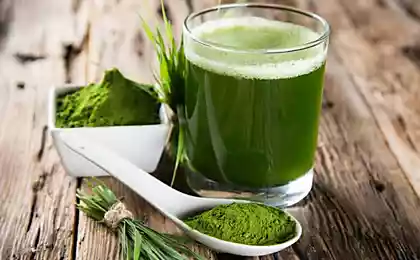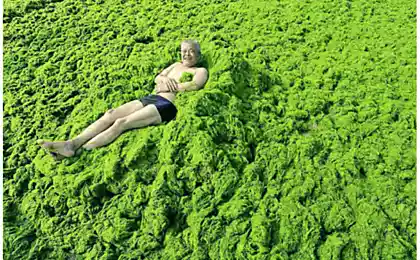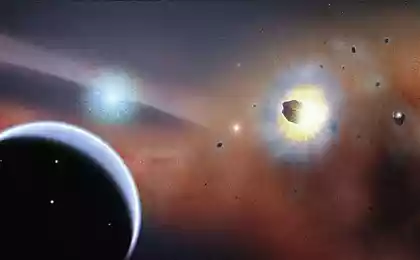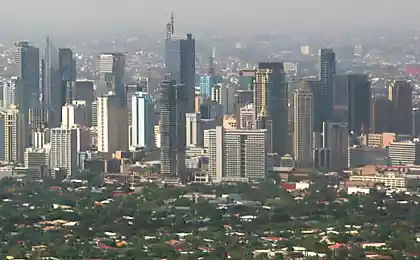438
8 incredible "pink" lakes of our planet
A pink lake is a lake that has a reddish or pink color due to the presence of algae that produce carotenoids (organic pigments). These include algae such as Dunaliella salina, which is a species of halophile green microalgae living in particularly salty seawater. Thanks to its pink color, these lakes are becoming increasingly popular with tourists and photographers from all over the world.
1. Hillier Lake, Australia
This body of water is located on the edge of the Middle Island, which is part of the Research Archipelago, stretching for tens of kilometers along the southern coast of Western Australia. A feature of the lake is its bright pink color. The color of the water is constant and does not change if the water is poured into the container. The length of the lake is about 600 meters. It is separated from the ocean by a narrow strip of land consisting of sand dunes covered with vegetation.
People first discovered the unusual lake in 1802. Then the British navigator Matthew Flinders decided to stop on the island on the way to Sydney. What was the surprise of the traveler, when among the dense forests of the island he came across a pink pond. The lake is surrounded by deposits of white salt and dense forests consisting of tea and eucalyptus trees. In the north, sand dunes separate the lake from the Southern Ocean.
The lake is very popular and tourists tend to get there, even passengers of planes flying over the lake take pictures of this natural wonder.
2. Retba (Retba), Senegal
Lake Retba, or Lake Pink, is located east of the Cap Vert peninsula in Senegal, northeast of Dakar, the capital of Senegal. It got its name because of the color of the water in which the algae of the species Dunaliella saltwater grow. The color is especially noticeable during the dry season. The lake is also known for its high salt content, which, like the Dead Sea, makes it easy for people to stay on the water.
There is a small salt mining business on the lake. Many salt collectors work 6-7 hours a day in the lake, which has a salt content of about 40%. To protect their skin, they rub “Beurre de Karité” (shea tree oil) into it, which softens the skin and prevents tissue damage. What is now called Lake Retba was once a lagoon. But the Atlantic surf gradually washed the sand and eventually the duct connecting the lagoon to the ocean was filled. For a long time, Retba remained an unremarkable salt lake.
But in the 70s of the last century, Senegal was hit by a series of droughts, Retba became very shallow and the extraction of salt, a thick layer of salt lying at the bottom, became quite profitable. At the same time, the water in the lake acquired a pink hue due to microorganisms that can exist in a saturated salt solution.
Amazing color water and charming boats completely cover the two-kilometer coastline of the Pink Lake, or Lake Retba - so it is called in the language of the Wolof, the largest ethnic group in Senegal.
Besides them, there is no other organic life in Retba - for algae, not to mention fish, such a concentration of salt is destructive. It is almost one and a half times higher than in the Dead Sea - three hundred and eighty grams per liter!
3. Salt Lake Torrevieja, Spain
Salt Lake Torrevieja and Salt Lake La Mata are the salt lakes surrounding Torrevieja, a seaside town in southeastern Spain. The microclimate created by the largest salt lakes in Europe – Torrevieja and La Mata – is declared one of the healthiest in Europe, according to the World Health Organization.
Alina de Torrevieja and La Salina de La Mata are the largest salt lakes in Europe. In the water grows a special kind of algae that gives the water a pink tint. The pink color of Lake Torrevieja, caused by the presence of algae and salt, gives it the appearance of “science fiction”. Just like the Dead Sea in Israel, you can just lie on the surface of the water. In addition, it will bring great benefits for the prevention and treatment of skin and lung diseases. At the other end of the lake, salt is extracted, exported to different countries. At the lake you can see a huge number of species of birds.
4. Hutt Lagoon, Australia
The Hutt Lagoon is depicted on the left side and the Indian Ocean on the right. The Hutt Lagoon is an elongated salt lake located near the coast north of the mouth of the Hutt River, in the middle west of Western Australia. It is located in the dunes adjacent to the coast.
The Hutt Lagoon was once the mouth of the 60km (37 mi) of the Hutt River, but at some point in the prehistoric past, the river changed its direction and the mouth remained isolated from both the river and the sea.
The city of Gregory is located between the ocean and the southern shores of the lake. The road between Northampton and Kalbarri, called George Grey Drive, runs along the western edge of the lake.
The lake acquired this color due to the abundance of the same algae that produce beta-carotene.
In this lagoon is the world's largest microalgae farm. The total area of small artificial ponds in which dunaliella saltwater is bred is 250 hectares. The length of the lake is 14 kilometers, and the width is 2 kilometers.
Lagoon Hutt is a salty pink lake that has a red or pink hue due to the presence of Dunaliella saltwater in the water. Algae of this species produce carotenoids, which are a source of beta carotene, a food colorant and source of vitamin A.
5. Lake Masazirgol, Azerbaijan
Lake Masazir is a salt lake in the Karadag area, near Baku, Azerbaijan. The total area of the lake is 10 square kilometers. The ionic composition of water contains large volumes of chloride and sulfate. In 2010, a plant for the production of 2 types of salt "Azeri" was opened here. The approximate supply of salt that can be extracted is 1735 million tons. It can be extracted both in liquid (from water) and in solid.
Due to the high content of sulfate, the water in the lake is pink.
6. Dust Rose Lake (Canada)
Located in British Columbia, Canada, this pink lake is quite unusual, little known and perhaps unique. The water in this lake is not salty and does not contain algae, but it still has a pink color. The photo shows pink water flowing into the lake. The color of the water is due to the unique combination of rocks in this area (stone dust from the glacier).
7. Pink Lake Quairading, Australia
Pink Lake Quayrading is located 11 kilometers east of the city of Quayrading (Western Australia). This is where the Bruce Rock Highway passes. The local population considers the Pink Lake a natural wonder. At some times, one side of the lake turns dark pink, while the other side remains pale pink.8 Pink Lake, Australia
Pink Lake is a salt lake in the Goldfields-Esperance region of western Australia. It is located about 3 kilometers west of Esperance and is connected to the east by the South Coast Highway. The lake is not always pink, but the distinctive color of the water, when the lake takes a pink hue, is the result of the activity of green algae Dunaliella saltwater, as well as a high concentration of saltwater shrimp. The lake has been noted as an important bird habitat by the international organization for bird protection and conservation.9 This unusual landscape was captured from a plane in Western Australia. This field of pink lakes is located somewhere between the city of Esperance and Caiguna. There are hundreds of small pink lakes on the field, and each of them has its own unique shade of pink. This is due to the fact that the concentration of algae and salt in each lake is different from all the others.
Source: www.ecology.md
1. Hillier Lake, Australia
This body of water is located on the edge of the Middle Island, which is part of the Research Archipelago, stretching for tens of kilometers along the southern coast of Western Australia. A feature of the lake is its bright pink color. The color of the water is constant and does not change if the water is poured into the container. The length of the lake is about 600 meters. It is separated from the ocean by a narrow strip of land consisting of sand dunes covered with vegetation.
People first discovered the unusual lake in 1802. Then the British navigator Matthew Flinders decided to stop on the island on the way to Sydney. What was the surprise of the traveler, when among the dense forests of the island he came across a pink pond. The lake is surrounded by deposits of white salt and dense forests consisting of tea and eucalyptus trees. In the north, sand dunes separate the lake from the Southern Ocean.
The lake is very popular and tourists tend to get there, even passengers of planes flying over the lake take pictures of this natural wonder.
2. Retba (Retba), Senegal
Lake Retba, or Lake Pink, is located east of the Cap Vert peninsula in Senegal, northeast of Dakar, the capital of Senegal. It got its name because of the color of the water in which the algae of the species Dunaliella saltwater grow. The color is especially noticeable during the dry season. The lake is also known for its high salt content, which, like the Dead Sea, makes it easy for people to stay on the water.
There is a small salt mining business on the lake. Many salt collectors work 6-7 hours a day in the lake, which has a salt content of about 40%. To protect their skin, they rub “Beurre de Karité” (shea tree oil) into it, which softens the skin and prevents tissue damage. What is now called Lake Retba was once a lagoon. But the Atlantic surf gradually washed the sand and eventually the duct connecting the lagoon to the ocean was filled. For a long time, Retba remained an unremarkable salt lake.
But in the 70s of the last century, Senegal was hit by a series of droughts, Retba became very shallow and the extraction of salt, a thick layer of salt lying at the bottom, became quite profitable. At the same time, the water in the lake acquired a pink hue due to microorganisms that can exist in a saturated salt solution.
Amazing color water and charming boats completely cover the two-kilometer coastline of the Pink Lake, or Lake Retba - so it is called in the language of the Wolof, the largest ethnic group in Senegal.
Besides them, there is no other organic life in Retba - for algae, not to mention fish, such a concentration of salt is destructive. It is almost one and a half times higher than in the Dead Sea - three hundred and eighty grams per liter!
3. Salt Lake Torrevieja, Spain
Salt Lake Torrevieja and Salt Lake La Mata are the salt lakes surrounding Torrevieja, a seaside town in southeastern Spain. The microclimate created by the largest salt lakes in Europe – Torrevieja and La Mata – is declared one of the healthiest in Europe, according to the World Health Organization.
Alina de Torrevieja and La Salina de La Mata are the largest salt lakes in Europe. In the water grows a special kind of algae that gives the water a pink tint. The pink color of Lake Torrevieja, caused by the presence of algae and salt, gives it the appearance of “science fiction”. Just like the Dead Sea in Israel, you can just lie on the surface of the water. In addition, it will bring great benefits for the prevention and treatment of skin and lung diseases. At the other end of the lake, salt is extracted, exported to different countries. At the lake you can see a huge number of species of birds.
4. Hutt Lagoon, Australia
The Hutt Lagoon is depicted on the left side and the Indian Ocean on the right. The Hutt Lagoon is an elongated salt lake located near the coast north of the mouth of the Hutt River, in the middle west of Western Australia. It is located in the dunes adjacent to the coast.
The Hutt Lagoon was once the mouth of the 60km (37 mi) of the Hutt River, but at some point in the prehistoric past, the river changed its direction and the mouth remained isolated from both the river and the sea.
The city of Gregory is located between the ocean and the southern shores of the lake. The road between Northampton and Kalbarri, called George Grey Drive, runs along the western edge of the lake.
The lake acquired this color due to the abundance of the same algae that produce beta-carotene.
In this lagoon is the world's largest microalgae farm. The total area of small artificial ponds in which dunaliella saltwater is bred is 250 hectares. The length of the lake is 14 kilometers, and the width is 2 kilometers.
Lagoon Hutt is a salty pink lake that has a red or pink hue due to the presence of Dunaliella saltwater in the water. Algae of this species produce carotenoids, which are a source of beta carotene, a food colorant and source of vitamin A.
5. Lake Masazirgol, Azerbaijan
Lake Masazir is a salt lake in the Karadag area, near Baku, Azerbaijan. The total area of the lake is 10 square kilometers. The ionic composition of water contains large volumes of chloride and sulfate. In 2010, a plant for the production of 2 types of salt "Azeri" was opened here. The approximate supply of salt that can be extracted is 1735 million tons. It can be extracted both in liquid (from water) and in solid.
Due to the high content of sulfate, the water in the lake is pink.
6. Dust Rose Lake (Canada)
Located in British Columbia, Canada, this pink lake is quite unusual, little known and perhaps unique. The water in this lake is not salty and does not contain algae, but it still has a pink color. The photo shows pink water flowing into the lake. The color of the water is due to the unique combination of rocks in this area (stone dust from the glacier).
7. Pink Lake Quairading, Australia
Pink Lake Quayrading is located 11 kilometers east of the city of Quayrading (Western Australia). This is where the Bruce Rock Highway passes. The local population considers the Pink Lake a natural wonder. At some times, one side of the lake turns dark pink, while the other side remains pale pink.8 Pink Lake, Australia
Pink Lake is a salt lake in the Goldfields-Esperance region of western Australia. It is located about 3 kilometers west of Esperance and is connected to the east by the South Coast Highway. The lake is not always pink, but the distinctive color of the water, when the lake takes a pink hue, is the result of the activity of green algae Dunaliella saltwater, as well as a high concentration of saltwater shrimp. The lake has been noted as an important bird habitat by the international organization for bird protection and conservation.9 This unusual landscape was captured from a plane in Western Australia. This field of pink lakes is located somewhere between the city of Esperance and Caiguna. There are hundreds of small pink lakes on the field, and each of them has its own unique shade of pink. This is due to the fact that the concentration of algae and salt in each lake is different from all the others.
Source: www.ecology.md























